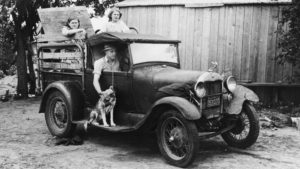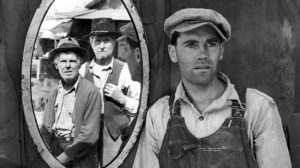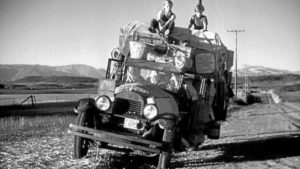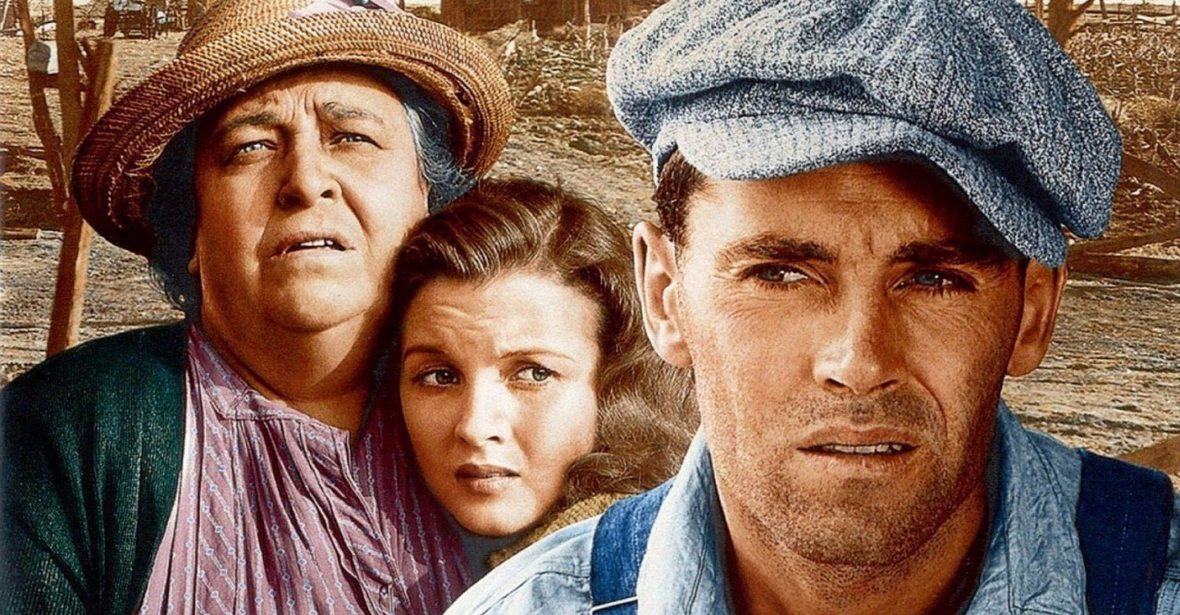The Grapes of Wrath is a 1940 drama movie directed by John Ford. The movie was based on John Steinbeck’s 1939 Pulitzer Prize winning novel of the same name. The screenplay was written by Nunnally Johnson and the executive producer was Darryl F. Zanuck. Take a look below for 27 more fun and interesting facts about The Grapes of Wrath.
1. The movie tells the story of the Joads, an Oklahoma family, who, after losing their farm during the Great Depression in the 1930s, become migrant workers and end up in California.
2. The movie is widely considered as one of the greatest American movies of all time.
3. In 1989, the movie was one of the first 25 films to be selected for preservation in the United States National Film Registry by the Library of Congress as being, “culturally, historically, or aesthetically significant.”
4. Prior to filming, producer Darryl F. Zanuck sent undercover investigators out to the migrant camps to see if John Steinbeck had been exaggerating about the squalor and unfair treatment meted out there. He was horrified to discover that, if anything, Steinbeck had actually downplayed what went on in the camps.
5. John Steinbeck loved the movie and said that Henry Fonda as Tom Joad made him, “believe my own words.”

6. John Ford banned all makeup and perfume from the set on the grounds that it was not in keeping with the tone of the picture.
7. While filming Joads’ car traveling down the highway, John Ford wanted to add a shot showing the large number of caravans heading west, so the film’s business manager stopped actual cars making the trek and paid the drivers $5 to escort the Joads’ jalopy for the cameras.
8. Noah Joad simply vanishes after the scene of the family swimming in the Colorado River. In the book, Noah tells Tom that he had decided to stay by the river. In the movie, his disappearance is never explained.
9. Although John Carradine hated John Ford’s bullying style of direction, he nevertheless made 11 movies with him over a period of 28 years. Ford was particularly keen on Carradine’s unusual look.
10. The pro-union stance of the movie led to both John Steinbeck and John Ford being investigated by congress during the McCarthy “Red Scare” era for alleged pro-Communist leanings.
11. Non-U.S. audiences saw the movie with a prologue which explained about the effects of the Depression and the Oklahoma Dust Bowl. The studio later referred to this version as the “Cliff Notes Edition.”

12. Darryl F. Zanuck paid $100,000 for the rights to John Steinbeck’s novel, which was a staggering amount of money at the time. Steinbeck only allowed the rights to be sold under the proviso that the filmmakers should show the material due reverence and treat the project responsibly.
13. The production had a fake working title, “Highway 66,” so that the shoot of the controversial novel wouldn’t be affected by union problems. Much of the dire straits portrayed in the movie continued during and after the release of the movie.
14. Beulah Bondi was tested for the role of Ma Joad. Bondi, believed that she had the part, reportedly bought an old jalopy and moved to Bakersfield, California, to live among the migrant workers in order to research the role. Bondi was reportedly extremely disappointed at losing the role.
15. Producer Darryl F. Zanuck knew that Henry Fonda was desperate for the part of Tom Joad, so he let it be known that he was going to offer the part to Tyrone Powder. Fonda pleaded with Zanuck for the part, and in order to get it, Zanuck talked him into singing an 80 picture deal with 20th Century Fox.
16. Woody Guthrie was an uncredited musical consultant for the movie, selecting “Goin’ Down the Road Feelin’ Dead” for use in the picture as a typical Okie song.
17. John Ford’s chief source of irritation was his inability to embarrass or upset John Carradine. According to Dorris Bowdon, Carradine had a huge ego, considered himself a great actor, and was impervious to whatever Ford threw at him, although their antagonism often produced perfect moments of performance and character.

18. Darryl F. Zanuck was heavily involved in all aspects of the production, as he saw it as a personal project. In fact, so meticulous and carefully thought through was his editing of Nunnally Johnson’s screenplay that Johnson himself praised Zanuck for his attention to detail.
19. The Grapes of Wrath is one of two John Ford directed movies to be nominated for the Academy Award for Best Picture in 1940. The other was The Long Voyage Home. Both lost out to Alfred Hitchcock’s Rebecca.
20. In the crucial scene between Tom and Ma, Henry Fonda had to strike a match whose light would illuminate Jane Darwell’s sleeping face. Gregg Toland rigged a tiny light in Fonda’s palm to achieve the effect.
21. John Ford unmercifully chewed Frank Darien for overemoting in the scene where Ma is preparing a simple stew for the family in front of a crowd of starving children in the migrant camp. By the time Ford had finished his tirade, Darien was completely drained, which proved to be exactly the take Ford wanted for the scene.
22. With the death of Shirley Mills on March 31, 2010, Darryl Hickman is the last surviving cast member of the movie.

23. Unusual for John Ford, he allowed Darryl F. Zanuck to supervise the editing. Indeed, Zanuck remains one of the very few producers to actually draw praise from the normally rather critical director.
24. The budget for The Grapes of Wrath was $750,000.
25. Far from being a leftist with an interesting in social problems, John Ford decided to focus on the story purely through the Joad family as character. He said, “I was sympathetic to people like the Joads, and contributed a lot of money to them, but I was not interested in Grapes as a social study.”
26. The truck used in the movie is a 1926 Hudson “Super Six”, which is the same model as in the book.
27. James Stewart was originally set to play Al, with Walter Brennan as Pa Joad.




